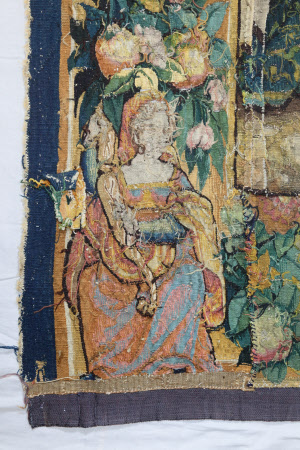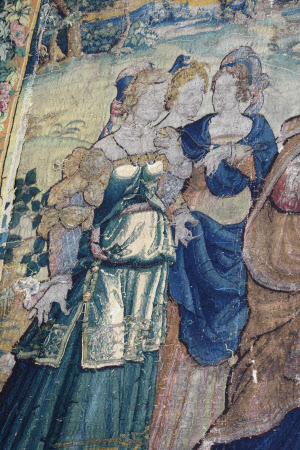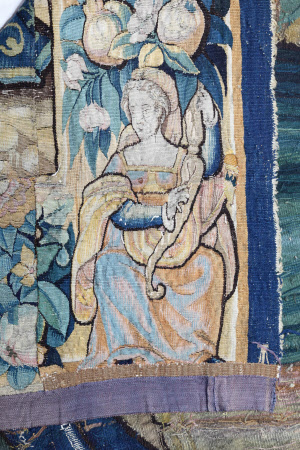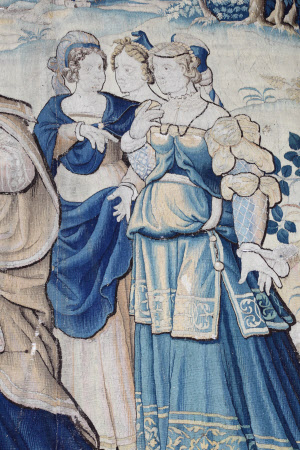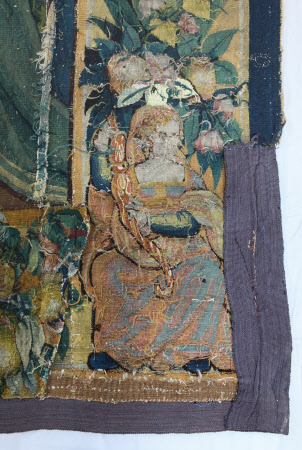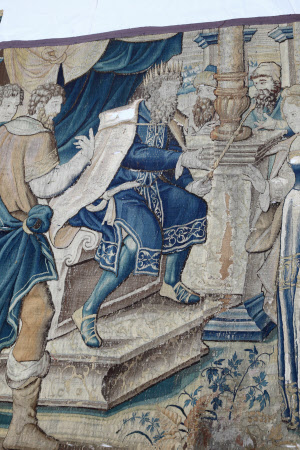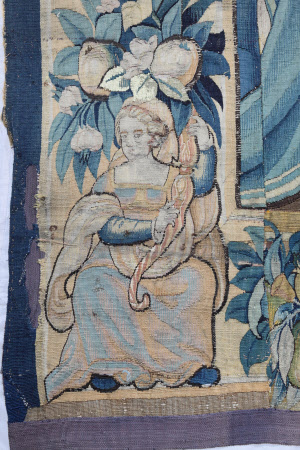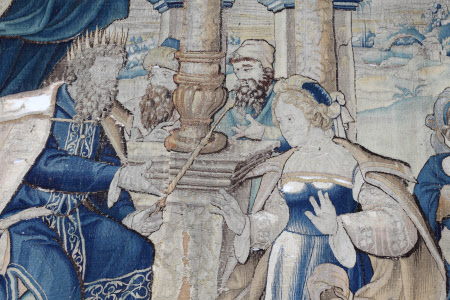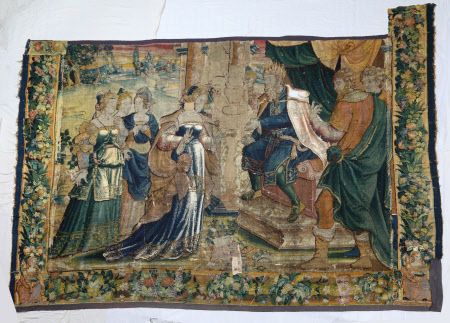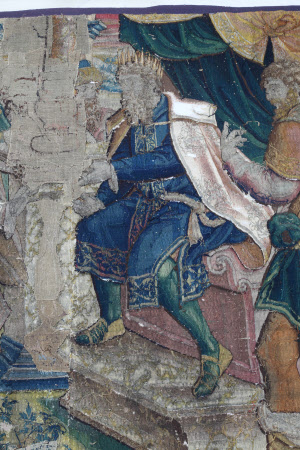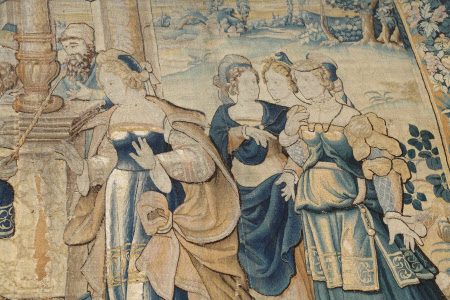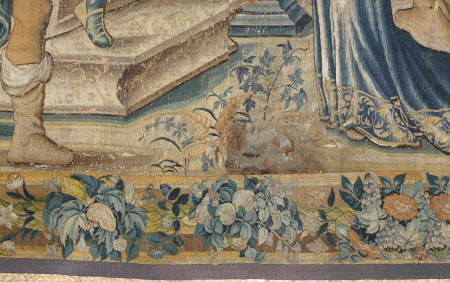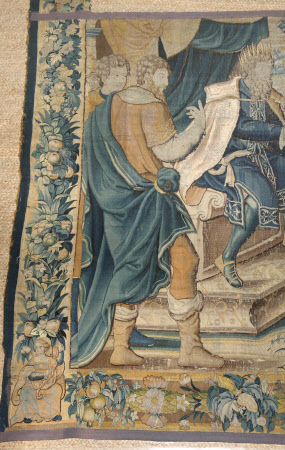Esther before Ahasuerus
Oudenaarde
Category
Tapestries
Date
circa 1545 - circa 1555
Materials
Tapestry, wool and silk, 4½ warps per cm
Measurements
3.08 m (H); 4.24 m (W)
Place of origin
Oudenaarde
Order this imageCollection
Hardwick Hall, Derbyshire
NT 1129474.3
Summary
Tapestry, wool and silk, 4½ warps per cm, Esther before Ahasuerus from a set of five Old Testament and Classical Subjects, probably Oudenaarde, c. 1545-1555. To the left King Ahasuerus, crowned and seated on a throne under a canopy of state, stretches out his hand and his golden sceptre to Esther, who stands before him with her head slightly bowed and both her hands raised in front of her. Male attendants surround the king's throne, and three maids stand behind Esther. The throne is set within an open columned structure and there is a landscape in the background. The borders of the tapestry are composed of a central palm trunk with bunches of different fruit and flowers arranged around it, with seated women at the two lower corners holding giant sticks of Brighton rock. There is a dark blue galloon around all four sides and in right-hand galloon at the bottom is part of a maker's mark. The two side borders have been cut off, taking with them a narrow strip of the main field, and then sewn back on to the tapestry. The upper border is missing.
Full description
The Story of Esther is told in the Old Testament Book of Esther. King Ahasuerus chose Esther as his queen after his original wife, Vashti, disobeyed him. Esther was originally presented to the King by her kinsman Mordecai, but she kept her Jewish parentage a secret. When the King's chamberlain Haman began to grow proud, and demand homage from everyone in the court, Mordecai refused to bow down before him. This provoked great anger in Haman, and he sent out orders in the name of the King for all the Jews in the Kingdom to be slaughtered, and their goods taken, on an appointed day. Mordecai heard of this and told Esther that it was her duty to go to the King and ask for mercy for her people. Esther replied that Ahasuerus had a rule that anyone who presented themselves to him unbidden would be executed, unless he touched them with his golden sceptre. Nonetheless she resolved to risk death to plead for the Jews to be spared. The tapestry shows Esther presenting herself to Ahasuerus, who extended his golden sceptre to her and asked her to present her petition. He granted her petition and elevated Mordecai to a high rank, because earlier Mordecai had told him of a plot on his life. Eventually the jealous Haman was hanged, and a new order was sent out in the name of the King by Mordecai, for all the enemies of the Jews to be slaughtered. 800 men were killed in the capital city of Shushan, and 75,000 in the rest of the Kingdom, but their goods were not taken. A group of five tapestries at Hardwick have identical borders and are the same height (allowing for the fact that two has lost their upper borders). Their subjects do not form a complete narrative, three coming from the Old Testament and the other two from classical history and mythology. 'The Judgement of Solomon' (1129474.4) and 'David Bringing the Ark of the Covenant to Jerusalem' (1129502) are related in narrative terms as David, who transported the Ark to Jerusalem, was the father of Solomon, and the two could come from a series of the 'Story of David' or the 'Story of Solomon'. Likewise the 'Rape of the Sabine Women' (1129474.1) and the story of 'Mucius Scaevola' (1129474.2) both form part of the founding myth of Rome, and could form part of a series of the 'Story of Rome'. 'Esther before Ahasuerus' (1129474.3) is not directly related to either story. It is possible that the five tapestries were part of a series embodying the exemplary virtues of the Old Testament and antiquity, rather than any particular narrative, but it seems more likely that panels from two or more different series have been combined. The borders are arranged around a central palm trunk with bunches of different fruit and flowers arranged around it at intervals. This structure ultimately goes back to a border type first used in Brussels in the 1530s, on the great tapestry sets designed by Bernard van Orley such as the Hunts of Maximilian. One of the tapestries, 'Esther before Ahasuerus', has the same basic border structure but with the addition of allegorical female figures at the lower corners. Two of the tapestries have the interesting feature of the feet of the main figures extending outside the frame into the border. This has the appearance of a playful trompe-l'oeil device, but may simply be the result of weaving a reduced-height version of an existing set of designs. Three tapestries in the set have maker's marks: 'The Judgement of Solomon' has a four-pointed mark in its upper galloon, 'David Bringing the Ark of the Covenant to Jerusalem' has a three-pointed mark with crossed ends, also in its upper galloon, and 'Esther before Ahasuerus' has the top of a mark shaped like an 'A' in its right hand galloon. None of the marks is recorded anywhere else. The appearance of three separate marks does not necessarily mean that the tapestries are not related, as it was common for more than one workshop to collaborate in the production of tapestry sets as a way of reducing risk and speeding up production. The style and colouring of the tapestries, and the shape and position of the makers' marks, all point to Oudenaarde as the probably place of manufacture, however the quality of the design is noticeably more refined than many Oudenaarde weavings of the period. The design is comparable to a series of the 'Story of Solomon' in the Château of Adzay-le-Rideau, which have similar borders to the Hardwick set with bunches of fruit around a palm trunk, and whose elegance and clarity have been have prompted de Meûter to compare them to contemporary Brussels tapestries (de Meûter 1999, pp. 147-151). The similarity of the 'Solomon' designs to the Hardwick tapestries makes it possible that both were the work of the same cartoon painter. The Adzay-le-Rideau 'Solomon' set bears the mark of the city of Oudenaarde and that of an unidentified weaver. The Oudenaarde city mark was introduced in 1544, and on the basis of the borders and the general style de Meûter has dated the set to c. 1544-1550, noting that this is probably the earliest tapestry set that can definitely be attributed to Oudenaarde. By analogy the set at Hardwick can be fairly securely attributed to Oudenaarde, and dated to the same period. Three tapestries with the same side borders as four of those at Hardwick are also recorded: a single panel with an unidentified subject in the Victoria and Albert Museum, which may represent 'The Departure of the Prodigal Son' or 'Tobias Taking Leave of his Father-in-Law' (Wingfield Digby and Hefford 1980, cat. no. 37, pp. 46-7 and plate 57), and two tapestries in the Museo degli Arazzi, Fabriano, a betrothal scene and a sacrifice (Marabottini and Marcelli 1997, pp. 137, 139). The tapestries may well have been at Hardwick in 1601 but they cannot be definitely identified in the 1601 inventory. The inventory includes in the Low Great Chamber (today the Dining Room) a set of eight 'David' tapestries measuring 11 feet in height – roughly 3.4 metres, the same height as the 'Old Testament and Classical Subjects'. No other 'David' tapestries have survived at Hardwick, however in the past it has been speculated that the 1601 'David' set may actually have been the eight-piece 'Scipio' set now in the State Withdrawing Room (no. 1129443). The first definite record of the present set comes in 1894 when two tapestries, the 'Judgement of Solomon' and 'David Bringing the Ark of the Covenant to Jerusalem', were in Lord Hartington's Bedroom, the present Lawn Room (Kerry 1894, p. 115). The tapestries were in the same location in 1945-6 (Devonshire 1945; Devonshire 1946). (Helen Wyld, 2011)
Provenance
Possibly at Hardwick by 1601, but certainly in the house by 1894; acquired through the National Land Fund in 1956 and transferred to the National Trust in 1959.
Credit line
Hardwick Hall, The Devonshire Collection (acquired through the National Land Fund and transferred to The National Trust in 1959)
Makers and roles
Oudenaarde, workshop
References
Levey and Thornton, 2001: Santina Levey and Peter Thornton (eds.), Of Household Stuff: The 1601 Inventories of Bess of Hardwick, London 2001 de Meûter et al., 1999: Ingrid de Meûter, Martine Vanwelden et al., Tapisseries d'Audenarde du XVle au XVllle Siècle, Tielt 1999 Marabottini and Marcelli 1997: Alessandro Marabottini and Fabio Marcelli, Pinacoteca Civica "Bruno Molajoli", Fabriano 1997 Wingfield Digby and Hefford, 1980: George Wingfield Digby and Wendy Hefford, Victoria and Albert Museum: The Tapestry Collection, Medieval and Renaissance, London 1980 Devonshire, 1945: Evelyn, Duchess of Devonshire, Notes on the 6th Duke’s Handbook, written for her daughter-in-law Mary Cecil, 1945 (Unpublished manuscript, Hardwick Hall) Devonshire, 1946: Evelyn, Duchess of Devonshire, Notes on Hardwick following the route of the 1601 inventory, 1946 (Unpublished manuscript, Hardwick Hall) Serra, 1921: Luigi Serra, La Pinacoteca Civica ed il Museo degli arazzi do Fabriano, Fabriano 1921 Kerry, 1894: The Rev. Charles Kerry, ‘Derbyshire Tapestries’, Derbyshire Archaeological Journal, vol. xvi (January 1894), pp. 86-139

